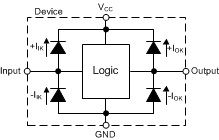ZHCSKW0C December 2019 – December 2021 SN74HCS00
PRODUCTION DATA
- 1 特性
- 2 应用
- 3 说明
- 4 Revision History
- 5 Pin Configuration and Functions
- 6 Specifications
- 7 Parameter Measurement Information
- 8 Detailed Description
- 9 Application and Implementation
- 10Power Supply Recommendations
- 11Layout
- 12Device and Documentation Support
- 13Mechanical, Packaging, and Orderable Information
封装选项
机械数据 (封装 | 引脚)
散热焊盘机械数据 (封装 | 引脚)
- BQA|14
订购信息
8.3.3 Clamp Diode Structure
The inputs and outputs to this device have both positive and negative clamping diodes as depicted in Figure 8-1.
CAUTION:
Voltages beyond the values specified in the Absolute Maximum Ratings table can cause damage to the device. The input negative-voltage and output voltage ratings may be exceeded if the input and output clamp-current ratings are observed.
 Figure 8-1 Electrical Placement of Clamping Diodes for Each Input and Output
Figure 8-1 Electrical Placement of Clamping Diodes for Each Input and Output